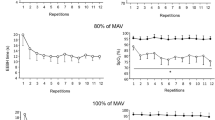Summary
Maximal aerobic power and related variables during submaximal work were determined on the bicycle ergometer and on the treadmill in nine long-distance runners and in nine control subjects.
During submaximal work, heart rate and pulmonary ventilation were similar with the two exercise procedures in each group, but the runners had lower values than the control subjects.
During maximal exercise, oxygen uptake and pulmonary ventilation reached higher levels on the treadmill than on the bicycle ergometer. The difference in \(\dot VO_2 \) max was not significant in the control subjects (4.4%), but was more pronounced (12.8%) and highly significant (p<0.01) in the runners. The intergroup differences for \(\dot VO_2 \) max between runners and controls were more marked during treadmill running (17.3%) than during bicycle exercise (8.5%).
It is concluded that the differences between the \(\dot VO_2 \) max values obtained on the bicycle ergometer and on the treadmill are influenced by the training conditions of the subjects and that bicycle ergometry leads to a marked underestimation of maximal oxygen uptake in runners.
Similar content being viewed by others
References
åstrand PO (1976) Quantification of exercise capability and evaluation of physical capacity in man. Progr Cardiovasc Dis 19:51–67
åstrand PO, Rodahl K (1970) Textbook of work physiology. McGraw-Hill, New York
Berggren G, Christensen EH (1950) Heart rate and body temperature as indices of metabolic rate during work. Arbeitsphysiologie 14:255–260
Clausen JP, Klausen K, Rasmussen B, Trap-Jensen J (1973) Central and peripheral circulatory changes after training of the arms or legs. Am J Physiol, 225:675–682
Hagberg JM, Giese MD, Schneider RB (1978) Comparison of the three procedures for measuring \(\dot VO_2 \) max in competitive cyclists. Eur J Appl Physiol 39:47–52
Hermansen L, Saltin B (1969) Oxygen uptake during maximal treadmill and bicycle exercise. J Appl Physiol 26:31–37
Hollmann W (1963) Höchst- und DauerleistungsfÄhigkeit des Sportlers. Barth, München
Hollmann W, Schmücker B, Heck H, Stolte A, Liesen H, Fotescu MD, Mathur DN (1971a) über das Verhalten spiroergometrischer Me\grö\en bei Radrennfahrern auf dem Lauf band und auf dem Fahrradergometer. Sportarzt Sportmed 22:153–158
Hollmann W, Heck H, Schmücker B, Stolte A, Liesen H, Fotescu MD, Mathur DN (1971b) Vergleichende spiroergometrische Untersuchungen über den Effekt und die Aussagekraft von Laufband- und Fahrradergometerbelastungen. Sportarzt Sportmed 22:123–134
Koyal SN, Whipp BJ, Huntsman D, Bray GA, Wasserman K (1976) Ventilatory responses to the metabolic acidosis of treadmill and cycle ergometry. J Appl Physiol 40:864–867
McArdle WD, Magel JR (1970) Physical work capacity and maximum oxygen uptake in treadmill and bicycle exercise. Med Sci Sports 2:118–123
McArdle WD, Magel JR, Delio DJ, Toner M, Chase JM (1978) Specificity of run training on \(\dot VO_2 \) max and heart rate changes during running and swimming. Med Sci Sports 10:16–20
McKay GA, Banister EW (1976) A comparison of maximum oxygen uptake determination by bicycle ergometry at various pedaling frequencies and by treadmill running at various speeds. Eur J Appl Physiol 35:191–200
Michael ED Jr, Hutton KE, Horvath SM (1961) Cardiorespiratory response during prolonged exercise. J Appl Physiol 16:997–1000
Miyamura M, Kitamura K, Yamada A, Matsui H (1978) Cardiorespiratory responses to maximal treadmill and bicycle exercise in trained and untrained subjects. J Sports Med 18:25–32
Parizkova J (1977) Body fat and physical fitness. Nijhoff, The Hague
Pechar GS, McArdle WD, Katch FI, Magel JR, De Luca J (1974) Specificity of cardiorespiratory adaptation to bicycle and treadmill training. J Appl Physiol 36:753–756
Shephard RJ, Allen C, Benade AJS, Davies CTM, Di Prampero PE, Hedman R, Merriman JE, Myhre K, Simmons, R (1968) The maximum oxygen uptake. An international reference standard of cardiorespiratory fitness. Bull Wld Hlth Org 38:757–764
Shephard RJ (1978) Human physiological work capacity. International biological programm 15. Cambridge University Press, Cambridge
Stromme SB, Ingjer F, Meen HD (1977) Assessment of maximal aerobic power in specifically trained athletes. J Appl Physiol: Respirat Environm Exerc Physiol 42:833–837
Vrijens J, Hoekstra P, Bouckaert J, Van Uytvanck P (1975) Effect of training on maximal working capacity and haemodynamic response during arm and leg-exercise in a group of paddlers. Eur J Appl Physiol 34:113–119
Author information
Authors and Affiliations
Rights and permissions
About this article
Cite this article
Pannier, J.L., Vrijens, J. & Van Cauter, C. Cardiorespiratory response to treadmill and bicycle exercise in runners. Europ. J. Appl. Physiol. 43, 243–251 (1980). https://doi.org/10.1007/BF00421838
Accepted:
Issue Date:
DOI: https://doi.org/10.1007/BF00421838




